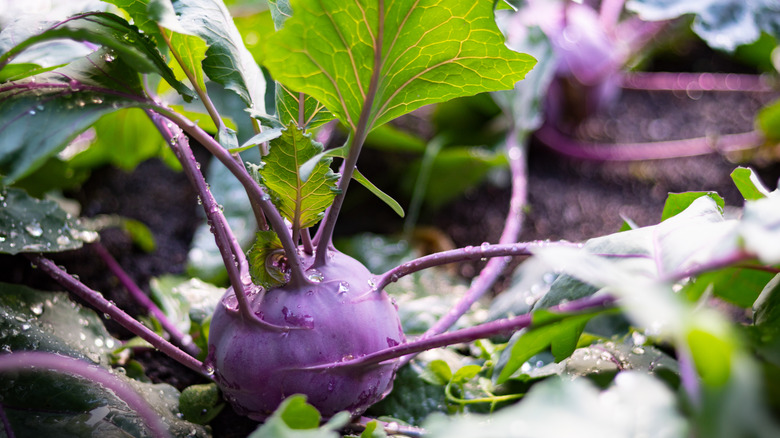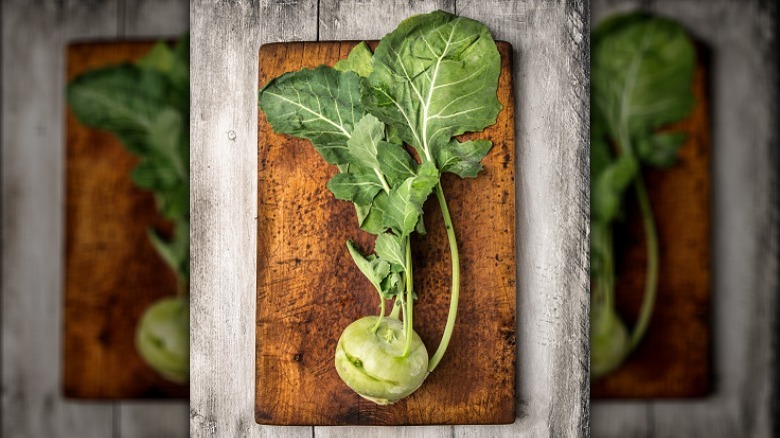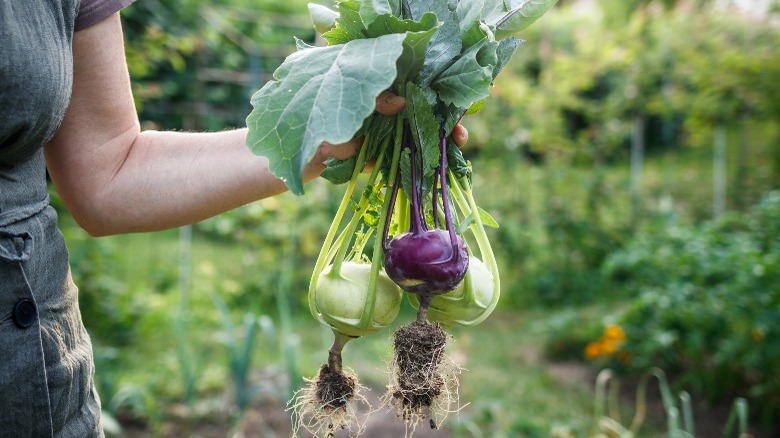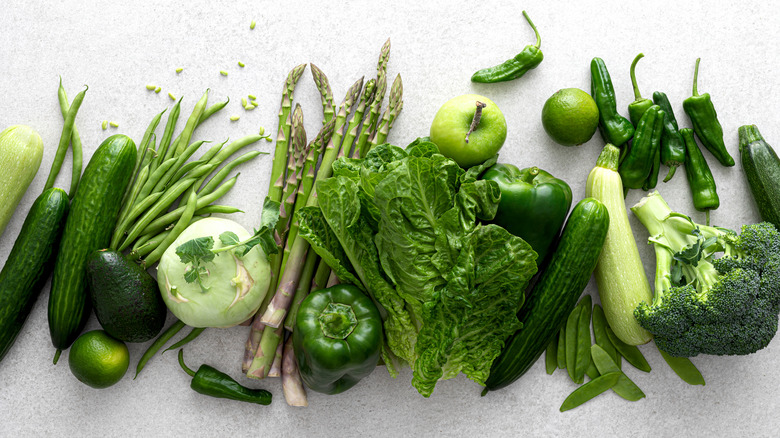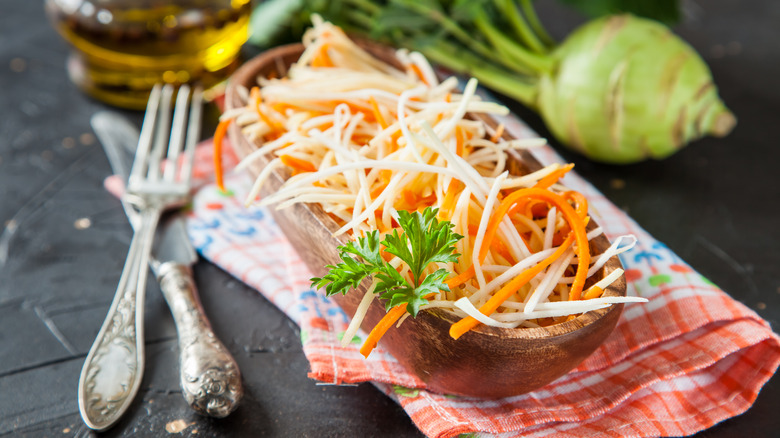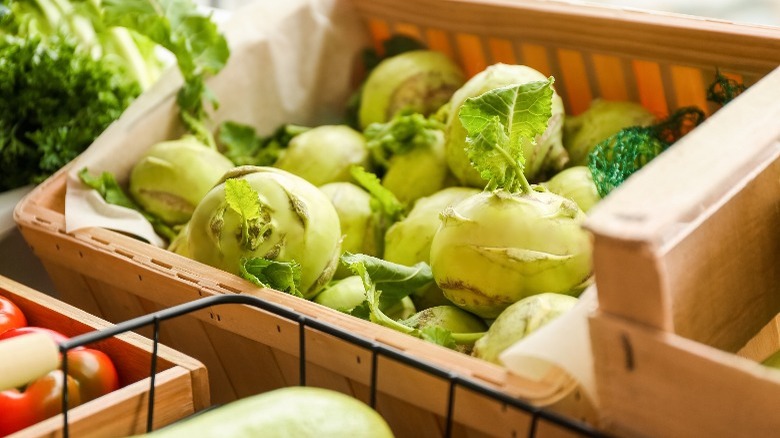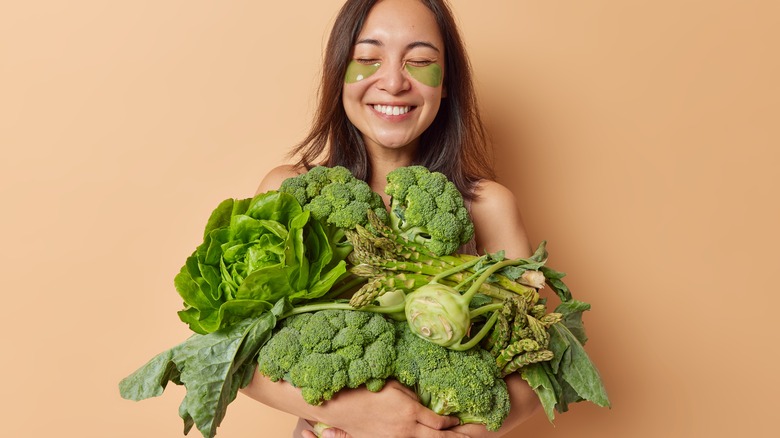What Makes Kohlrabi Unique?
Kohlrabi (Brassica oleracea var. gongylodes), though popular in other regions of the world, still flies under the radar in many American kitchens. The CSA box may be the first place one learned about the lesser-known vegetable, or it could have appeared in a dish scarfed down without awareness. Once it's deleafed, peeled, grated, or cubed, it's lost much of its defining characteristics: the pale green or purple ovoid or squat bulb, sprouting waxy kale-like leaves on slender stalks. And its flavor, moderate to begin with, may have been unremarkable. So why has kohlrabi endured instead of being absorbed into the massive lexicon of extinct, or at least esoteric, edible plants?
A mild peppery flavor not unlike other members of its plant species, such as cabbage and brussels sprouts, and a snappy, crisp texture lend kohlrabi great appeal. It's pretty simple to process in comparison to a sugar pumpkin, for example, encased in thick, slippery skin, or even kohlrabi's cruciferous kin, broccoli, which requires the stalks be separated into florets, soaked, trimmed, and chopped. Popular in India, Germany, and Vietnam, per Eater, kohlrabi presents many methods for enjoying it and accepts a variety of seasonings. It can be eaten raw and cooked, and most of the plant is edible. Undemanding cultivation, rapid growth, and cold hardiness, via The Old Farmer's Almanac, make kohlrabi an easy sell for farmers, especially as its familiarity increases among consumers. Read on about this strange-looking bulb with a sweet bite.
What is kohlrabi?
According to the German Food Guide, kohlrabi is a cross of wild cabbage and turnip, developed in 16th-century Northern Europe. The name is a logical conclusion: A combination of the German kohl (cabbage) and rabi (turnip). Consumed there since the mid-1500s, more kohlrabi is grown and eaten in Germany than in any other country. Although the publication contends the world perceives their beloved kohlrabi as German food, it's cultivated and consumed in several regions throughout the globe. It features heavily in certain cuisines not exclusive to Europe.
Kohlrabi is a member of the brassica family, like the inspirations for its title, along with cauliflower, brussels sprouts, broccoli, kale, and collard greens. You may see it in white (green) or purple (red), yet either color provides a similar growing and taste experience, per The New York Botanical Garden. The turnip-like bulb is an enlarged stem that grows above ground and is the 'meat' of the vegetable; the leaves, if still attached and large enough to bother with, are edible too. However, the root, usually trimmed before kohlrabi is sent to market, should be tossed into the compost.
How to grow kohlrabi
A cool-weather crop, kohlrabi offers hardiness in cultivation for zones 2 to 11, with a growing season that extends into the winter months in some regions. Per the Missouri Botanical Garden, homegrown seedlings or nursery transplants should be spaced 4 to 6 inches apart with 18 inches between rows. It's imperative to maintain enough room between the plants for the bulbs to develop into the desired size. They prefer moist soil and full sun; a top layer of mulch can be added to help retain moisture and prevent weed growth.
According to The Seed Collection, kohlrabi is a rapid grower, reaching optimal harvest size in approximately 10 weeks. They should be watered consistently as overly dry soil produces a tough woody stem. However, they are moderately drought tolerant, provided the temperature is not too hot. Once the bulbs are about 2 to 3 inches in diameter, they are ready to be harvested, and although older and larger kohlrabi is not as tender, they're still certainly edible. It's best to pick kohlrabi as needed; therefore, consider a sowing schedule that offers a revolving supply of mature vegetables.
Common pests include birds, snails, slugs, aphids, and cabbage moth caterpillars. The Seed Collection recommends netting to protect against birds and cabbage moths — particularly in the seedling stage — while a soap and water spray can be employed against aphids. All said, kohlrabi is a fairly low-maintenance and quick-growing vegetable that deserves a spot in your garden.
What does kohlrabi taste like?
Per the Los Angeles Times, except for the root, the entirety of the kohlrabi plant is edible; this includes the most frequently consumed part — the bulb-like stem, the leaf stalks, and the leaves. California grower Roger Queen cultivates a green and purple variety yet notes their flavors are very similar. Some compare the freshness and taste of the bulb to cabbage hearts (though kohlrabi is milder) and broccoli stems — a little sweet and a bit peppery. "If you've ever met people who are really into eating the inside of the broccoli stem — there's this nice white crunchy part — it's kind of like that," said Alessandro Ascherio, farm field manager, in Eater. "It's not bitter. It's mild and sweet," he explained.
According to the Sustainable Food Center, 2 to 3-inch bulbs are the ideal size for consumption. They've reached maturity but still have a delicate flavor and tender skin that doesn't need to be peeled. The younger stems may even be somewhat juicy; Brad Leone, the test kitchen manager for Bon Appétit, likens their crispy juiciness to an apple. Kohlrabi leaves taste like other brassica greens, such as kale, savoy cabbage, bok choy, and collards, yet aren't as assertive as bitter mustard greens. When cooked, which is a better preparation for larger woody bulbs as opposed to eaten raw, kohlrabi becomes tender. It can contribute its distinctive yet subtle mustardy addition to a stewed or braised dish.
How to cook with kohlrabi
Kohlrabi has a subdued flavor that works well in raw preparations such as vegetable slaws and salads, and as an ingredient, its crunchy, fresh texture is equal to the taste. Roger Queen said in the Los Angeles Times that he likes it served, especially smaller orange-sized stems. "It's good just to slice up and add it to a fresh vegetable tray."
Most often, though, kohlrabi shows up in cooked form like its brassica relatives. Yet unlike these, which usually comprise the feature component of an American meal, particularly one that leans plant heavy — broccoli cheddar soup, brussels sprouts with bacon, kale Ceasar, and whole pot-roasted cauliflower, for instance — kohlrabi plays more of a supporting role. That's the case in Indian cuisine, where it also appears in stews and curries. "If you go to India, you would find it is in most regional cuisines but it's never a star dish," noted food writer Lopamudra Mishra in Eater. The exception to backseat status is when it's pickled — per Mishra, kohlrabi is ideal as a condiment. In Vietnam, it might be a component of stir-fries. In Germany, whole bulbs are stuffed with ground beef and cheese, or braised kohlrabi in cream plays foil to schnitzel (via German Food Guide).
Don't neglect to use the leaves, which look similar to Tuscan kale, if they're appealingly firm and plentiful. Bon Appétit suggests a classic sauté featuring olive oil, garlic, and crushed red chili flakes.
Where to buy kohlrabi
Kohlrabi is frequently available year-round at supermarkets per HowStuffWorks and can be seen in farmers markets and CSA (Community Supported Agriculture) subscription boxes when in season. "I always recommend buying organic from a farmers' market for the freshest and most tasty specimens," recommends Brad Leone (via Bon Appétit). Additionally, he suggests choosing kohlrabi, which still has its leaves. "It's a good indicator that the veg is fresh, and that it was harvested recently, because the leaves wilt faster than the bulb." However, slice the leaves off immediately without penetrating the outer skin; the unpeeled bulbs can be kept loose in the refrigerator for several weeks. The leaves should be placed inside an air-tight plastic bag in the fridge. And it bears repeating — select smaller bulbs when given the option, especially if you're aiming to serve them raw.
If you look long enough, you might come across linguine made from the veggie as an alternative to traditional wheat pasta. And while it's rare to find kohlrabi sold in frozen form, like its more popular cauliflower cousin, it's available riced. (Maybe kohlrabi will have its fifteen minutes of fame after all! Albeit masquerading as something else.)
Nutritional information about kohlrabi
Per the Sustainable Food Center, kohlrabi contains the minerals potassium, magnesium, iron, and calcium, as well as vitamins C, A, and K. According to Web MD, Calcium and magnesium play a valuable role in maintaining bone health, while vitamin C helps to boost immunity and prevent infection. Further, plentiful fiber and phytochemicals, plant compounds such as polyphenols and carotenoids that exhibit significant antioxidant benefits, are present in kohlrabi and have been indicated to aid in the prevention of various cancers, heart diseases, and digestive ailments. The plant is also high in folate, an essential nutrient for cell growth. It's often prescribed in synthetic form to pregnant women due to its function in decreasing congenital disabilities of the spine and brain (via the Mayo Clinic). On the other hand, kohlrabi is low in fat, sugar, and sodium.
Several healthy juice and smoothie recipes call for incorporating freshly grated bulb or chopped leaves to increase the total bulk, fiber, and nutrients. Yet, LiveKindly suggests including romaine lettuce, apples, or cucumber to temper any bitterness the kohlrabi might contribute. Kohlrabi could be good for our outsides too. Anti-aging, soothing, and nourishing facial masks shared by Confettissimo mix kohlrabi with fruits, vegetables, sour cream, and honey, among other foodstuffs for healthy skin.
